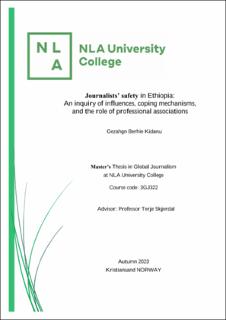| dc.description.abstract | Hostility against journalists has intensified around the globe, more so in insecure democracies. Different facades of influences on media and journalists mean constraints on journalistic content. Accordingly, this thesis attempts to harness influences and journalists’ safety in Ethiopia, thereby what this bears in news production as journalists grapple with diverse influences and hostilities. The thesis also tries to explain the role played by three journalistic associations in putting a wall of protection around journalists. To achieve this, qualitative research is espoused. The thesis adopted purposive sampling in order to catch journalists who encountered hostility. Twenty-three journalists and three professional association presidents were drawn through semi-structured interviews. Participants are varied across media ownership, in which the 23 journalists work under 12 media institutions (state, private, and transnational) and practice journalism in print, broadcast, and online media. While thematic analysis is employed to synthesise and reiterate research questions, conceptual framework, and data, coding is accomplished through MaxQDA.
Results reveal that ethnicity, which mirrors the political setting, influences journalism practice, which stretches to how media institutions assign reporters to cover news stories and curtails investigative reporting. Discriminatory provision of access to information is an added predicament for journalists working in private and transnational media. The war in northern Ethiopia is explained as having an adverse effect on the achievements to media freedom gained after the 2018 political change in the country. A few participants have been through a near death experience as they faced torture, while several have encountered abduction, arbitrary arrests, and verbal abuse. When journalists get a chance to appear before a court of law, they are often slammed with bogus charges such as “terrorism” and “defilement of the Constitution”. Women journalists are especially targeted in digital harassment, and journalists working in transnational media are labelled as “traitors” who “sell” their country for dollars.
For the most part, hostility against journalists is piled up by different bodies of government. The state apparatus goes to great lengths to assault, discredit, and silence journalists, mainly working in private media. The lack of prosecution against attacks and perpetrators of violence creates further insecurity for journalists. Journalists explain that attacks bear the brunt of their personal and financial well-being and professional credibility. This also indicates that attacks on journalists are formed against what they endeavour to embody and accomplish in their occupation. Journalists practice self-censorship and procrastination with cross-ownership nuances to mitigate hostility toward themselves and their media business. This is true for many participants in this study. While organisational and routine level influence is used in full force to winnow, acquiesce, and silence journalists in state media, assorted hostility committed against journalists in private and transnational media explains submission. However, a few journalists defy hostilities and showed epitomes of resistance against the writing on the wall. Journalistic associations’ efforts in organising capacity-building mechanisms, condemning assaults on news workers, and establishing an ombudsman are noble steps, while power dynamics still overwhelm their exertion. Finally, the thesis suggests that studies about journalists’ safety in insecure democracies need to investigate the seriousness of hostility factors in spite of enshrined press freedom laws and examine how media resilience can be achieved within this context. | en_US |
